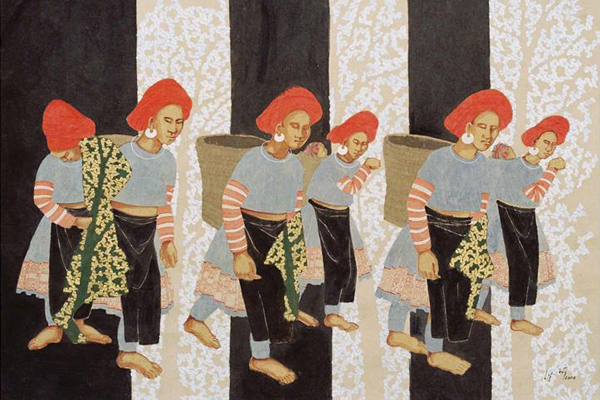“For now,” she says, “Greg can finish these off.” And, as if reading her mind, Greg Copeland (GC Innovations: design, space planning, reforms, custom carpentry) arrives to take over.
In the elevator going back up to the apartment, which doubles as an exhibition space and a home for husband, Jack, and four sons aged 12 through 18 (who go through 40 liters of milk a week), she checks and signs off for a package being delivered.
“Images,” she reveals. “Critical prints of new paintings by Le Thanh Son that I need for the Web site ahead of his exhibition. Now I can finish it off.”
Capable, organized and adaptable, Thomas and her husband came to Japan in 1992 with a baby and a toddler. For years after, her life was centered around children and schools — PTA, trustee of the board, chair of the board. Then, in 2004, the family decamped to the U.S. for a year.
“By that time, art was a big factor in my life. I knew what I wanted to do — establish a permanent gallery of Vietnamese art — but Oregon was not the place. There was a lot of soul searching.”

Having first visited Vietnam in 2000, Thomas had quickly become intrigued by the quality of its art. “It was bright, different, and very good from a price performance perspective. Indian and Chinese art markets were beginning to boom. But Vietnamese artists were not getting the recognition they deserved.”
The family returned to Tokyo in November 2005. Thomas went to Vietnam in December and started making contacts. She opened Toriizaka Art in March 2006, since when it has “evolved.”
“Mistakes? Of course I’ve made mistakes. Mis-pricing items, for example — there are people in the world with great bargains! But then price is always difficult. Some people who come here to look at what I have on offer say, “Oh, too expensive.” Others imply “too cheap.” Also one partner of a couple may not like something, to which nowadays I always advise, “Forget it. Don’t buy it.”
Luckily, her own husband never comments on any of the work she brings in. If he has opinions, he keeps them to himself, concentrating on being wholly supportive.
“Jack designed my Web site so that I can update it myself. He helps with exhibitions — puts up picture rails, moves lighting.
“Never complains that every inch of wall space is covered from top to bottom, that closets are fit to bursting. The boys are the same. Great kids. Very tolerant, very helpful.”
This is not to say she does not have to be circumspect. A recent shipment of paintings — Buddhist monks painted in oil on large canvases, almost in the style of a watercolor, line one corridor, their faces to the walls: “Just in case. . .”
We eat in the kitchen (under another wall of artwork) and it’s Thai food and delicious! Ja has been nanny, friend, cook and housekeeper for 16 years; she moved with them when they tried Oregon; her family has visited Tokyo; the Bird-Thomas menage has met with her relatives in Thailand. It really is one big happy family, which goes a long way to explaining the success of Toriizaka Art.
In her first year, Thomas sold around 100 artworks — figurative, landscapes, abstract, symbolic. Last year she sold 175.
Interested parties can arrange to come to the apartment, preferably by appointment since it is also her home. She also stages a monthly in-house event, the dates of which can be checked out on her Web site.
Thomas likes the slow pace of the business she is developing. Yes, of course she’s busy, but it’s through choice, never imposed. Happy buyers spread the word, so she’s never found the need to advertise. Consistency is the key: in the quality of the pieces and the artists she represents.
The painter who focuses on monks, Nguyen Minh Phuoc, depicts them walking away into the distance, an effect that is both ethereal and full of mystery.
Trinh Quoc Chien, a devout Buddhist who works in lacquer, mixes gold leaf, mother-of-pearl and stone for three-dimensional effects and images that reflect his meditative process.
Bui Huu Hung is interested in recording Vietnamese history and he is prolific. But Thomas says she may see 50 pieces before she brings one into Japan. “I’m picky.” From next week, she will focus on the exhibition of paintings by Le Thanh Son, planned to open April 12 at Shinsei Bank’s headquarters in Yurakucho. It’s a fabulous exhibition space, she enthuses, “up on the 20th floor, overlooking Hibiya Park”


